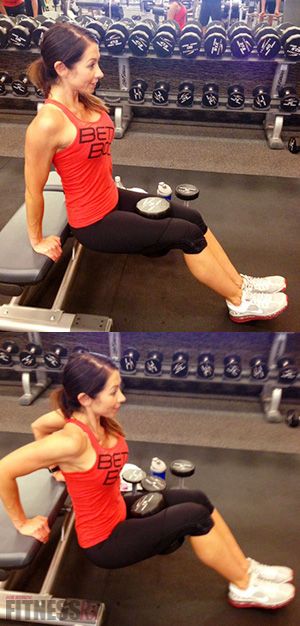Nowadays people can work anywhere, and many of us have had to transition to working from home whether we like it or not. While the traditional office setting has undergone major changes lately (including having no office whatsoever), when it comes to exercise, some things really can’t be improved upon. That includes many of the “old school” exercises that have been the foundation of training for decades. One of these gems is the bench dip. This is an exercise that attacks the muscles of your shoulders, chest and triceps with vigor, yet is so simple to do – and you don’t need high-speed Internet or Zoom to do it effectively! Thus, it’s a great exercise for when you’re away from your home gym, when you need to relieve stress, or if you really want to attack your upper body with some serious training efforts.
Muscles Used
Bench dips affect the pectoralis muscles and, depending on your hand and arm positions, the triceps brachii muscles will be activated to varying degrees. The large fan-shaped pectoralis major muscle has two heads. The clavicular head of the pectoralis major begins on the anterior (front) surface of the clavicle (collarbone), whereas the sternocostal head of the pectoralis major attaches along the lateral edge of the sternum and the upper six ribs. Both heads of the pectoralis major muscle come together and attach to the head of the humerus bone of the upper arm, near the shoulder joint. The heads of the pectoralis major work together to adduct the humerus (move the arm toward the midline of the body), and flex the humerus (move the humerus bone of the upper arm anteriorly). Bench dips primarily activate the flexor components of the pectoralis muscle.
The triceps brachii muscle and especially the long head of the triceps are also strongly activated in the bench dip exercise. The long head of the triceps or the “inner head” achieves the greatest activation in dips of this three-headed muscle because it both extends the arm at the shoulder joint (pulls the upper arm backward during the controlled descent) and extends the forearm at the elbow joint (straightens the elbow) during the upward movement. The long head of the triceps runs from the scapula (shoulder blade) just below the shoulder joint and joins the medial and lateral heads of the triceps brachii to cross the elbow and attach to the ulnar bone in the forearm. The lateral head begins high on the humerus bone, but it does not cross the shoulder joint. The medial head begins in the middle of the humerus bone. It’s mostly buried by the other two heads, but part of it can be seen above the elbow. The medial and lateral heads of the triceps brachii also contribute strongly to elbow extension, by helping the long head to raise the body during each repetition.
Bench Dips
1. If you have access to a real bench (i.e., you are at a park or in your gym), you may sit as if you were going to sit down to look at your tablet or read a book. Your upper body and legs will be at 90 degrees to the long axis of the bench. A solid (not heavily padded) chair will work, as long as it is in a place where it will not slip; sometimes a firm couch will also work. Hold on to the edge of the bench with your hands about shoulder-width apart. Stretch your legs out so that your knees are straight and your heels make contact with the ground. Your hips should be bent and only heels and hands should be in contact with the floor and bench, respectively.
2. Slide feet forward so that your hips move off of the bench. Hold tightly to the edge of the bench you were sitting on (it is now behind you) so that your upper body is supported by your hands, which are now behind you. The contact point of your heels should be on the ground in front of you. Use your heels as a pivot point, as you lower your buttocks toward the floor. Lower your body within three to four seconds, in a slow and controlled fashion.
3. At the bottom position, your hands should be at the level of your axilla (armpits) and your buttocks should not contact the floor. If you do not feel a super stretch in your pectoralis and the long head of your triceps, then your bench is too low. You should work into this depth over a few weeks, as your shoulders will need the time to adapt to the stretch. If the distance between your heels on the floor and the bench is too short (i.e., you are not stretched out enough), your back may contact the bench as you lower your body toward the floor. If this occurs, stop the exercise and reposition your feet. While a good stretch is important, be very cautious on the descent and do not go too deeply if you have injured your shoulder or you experience any shoulder pain. Hold the bottom position for a count of two because this will increase the tension and stretch on the pectoralis muscles.
4. From the bottom, straighten (extend) your elbow joint to push your body upward and to lift your buttocks from near the floor. The upward phase can be more explosive than the descent and it should take only one to two seconds to complete the full upward push. Do not completely lock out your elbow joint at the top, or you will reduce the tension in your muscles. After reaching the top, move immediately to the controlled descent. The upward lift activates both heads of the pectoralis and all three bellies of the triceps brachii. After a month or two, if you want to increase the work for the triceps and tighten the back of your arm, so you can move your hands closer together on the bench (so they are behind your back, about four inches apart).
5. Try to do 15 reps, and then take a break. Work up to three sets for this exercise; you can increase the number of reps if this is too easy.
6. When you have finished the set, use your thighs to lift your body and sit back on the bench.
7. You should inhale as you descend and exhale on the push upward. Although it is easier, holding one’s breath is not a good idea in any exercise, especially for persons who are middle-aged or older, or for someone who has high blood pressure or cardiovascular disease.
When you can achieve 30 reps without much effort, it is time to move to a more difficult form of the exercise. Instead of having your feet on the ground, you can place both heels on a small box (which won’t move) or on another bench or low chair. Everything else is performed the same way, but the degree of effort is significantly greater when your feet are elevated.
It is important that you control your descent and resist gravity on the way down. Also, be very careful about pushing upward in an explosive manner, especially if you start from a stretched position at the bottom and particularly if you have progressed to having your feet elevated. If you really want to explode upward, you should first use this exercise regularly for a few months, because this will allow time for your tendons to accommodate the stress and stretch of the movement. Even then, don’t do this with reckless abandon, unless you are hunting for an injury. If you are doing this exercise correctly, you should feel a very strong pull in the pectoralis across the entire chest – but the pectoralis tendon should not feel like it is trying to launch itself from the attachment on your shoulder, either.
You do not have to wait until you are away from civilization to do this exercise. It’s an effective finishing exercise for your upper body workout when you’re at the gym. Sure, there is not much glamour in this low-tech exercise, and you don’t need to employ a chrome high-tech electronically mediated training machine to get it done. However, exercise effectiveness cannot be judged on how technologically advanced the equipment might be; it should be judged on the effort extended by the muscles, and the results that are achieved by this effort.
Occasionally, stepping back into the past and extracting simple exercises, like bench dips, is the best way to launch yourself forward into a firmer and more shapely future.
References:
Coke LA, Staffileno BA, Braun LT and Gulanick M. Upper-body progressive resistance training improves strength and household physical activity performance in women attending cardiac rehabilitation. J Cardiopulm Rehabil Prev, 28: 238-245, 2008.
David, G., M. E. Magarey, M. A. Jones, Z. Dvir, K. S. Urker, and M. Sharpe. EMG and strength correlates of selected shoulder muscles during rotations of the glenohumeral joint. Clin Biomech, (Bristol, Avon) 15: 95-102, 2000.
Eiserloh, H., D. Drez, Jr., and C. A. Guanche. The long head of the triceps: a detailed analysis of its capsular origin. J Shoulder Elbow Surg, 9: 332-335, 2000.
Galvao DA and Taaffe DR. Resistance exercise dosage in older adults: single- versus multi-set effects on physical performance and body composition. J Am Geriatr Soc, 53: 2090-2097, 2005.
Gjovaag TF and Dahl HA. Effect of training with different intensities and volumes on muscle fibre enzyme activity and cross-sectional area in the m. triceps brachii. Eur J Appl Physiol, 103: 399-409, 2008.
Harwood B., Edwards DL and Jakobi JM. Age- and sex-related differences in muscle activation for a discrete functional task. Eur J Appl Physiol, 103: 677-686, 2008.
Moore, K.L., and A.F. Dalley. Clinically Oriented Anatomy, Fourth Edition, Lippincott, Williams & Wilkins, 1999: p72-79, 724.
The post Get Firm and Shapely Shoulders and Arms first appeared on FitnessRX for Women.




